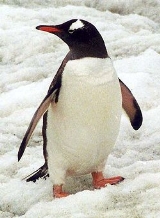
Penguin
Overview
Penguins are a group of aquatic
, flightless
bird
s living almost exclusively in the southern hemisphere
, especially in Antarctica. Highly adapted for life in the water, penguins have countershaded
dark and white plumage, and their wings have become flippers
. Most penguins feed on krill
, fish
, squid
, and other forms of sealife caught while swimming underwater. They spend about half of their lives on land and half in the oceans.
Although all penguin species are native to the southern hemisphere, they are not found only in cold climates, such as Antarctica.
Aquatic animal
An aquatic animal is an animal, either vertebrate or invertebrate, which lives in water for most or all of its life. It may breathe air or extract its oxygen from that dissolved in water through specialised organs called gills, or directly through its skin. Natural environments and the animals that...
, flightless
Flightless bird
Flightless birds are birds which lack the ability to fly, relying instead on their ability to run or swim. They are thought to have evolved from flying ancestors. There are about forty species in existence today, the best known being the ostrich, emu, cassowary, rhea, kiwi, and penguin...
bird
Bird
Birds are feathered, winged, bipedal, endothermic , egg-laying, vertebrate animals. Around 10,000 living species and 188 families makes them the most speciose class of tetrapod vertebrates. They inhabit ecosystems across the globe, from the Arctic to the Antarctic. Extant birds range in size from...
s living almost exclusively in the southern hemisphere
Southern Hemisphere
The Southern Hemisphere is the part of Earth that lies south of the equator. The word hemisphere literally means 'half ball' or "half sphere"...
, especially in Antarctica. Highly adapted for life in the water, penguins have countershaded
Countershading
Countershading, or Thayer's Law, is a form of camouflage. Countershading, in which an animal’s pigmentation is darker dorsally, is often thought to have an adaptive effect of reducing conspicuous shadows cast on the ventral region of an animal’s body...
dark and white plumage, and their wings have become flippers
Flipper (anatomy)
A flipper is a typically flat limb evolved for movement through water. Various creatures have evolved flippers, for example penguins , cetaceans A flipper is a typically flat limb evolved for movement through water. Various creatures have evolved flippers, for example penguins (also called...
. Most penguins feed on krill
Krill
Krill is the common name given to the order Euphausiacea of shrimp-like marine crustaceans. Also known as euphausiids, these small invertebrates are found in all oceans of the world...
, fish
Fish
Fish are a paraphyletic group of organisms that consist of all gill-bearing aquatic vertebrate animals that lack limbs with digits. Included in this definition are the living hagfish, lampreys, and cartilaginous and bony fish, as well as various extinct related groups...
, squid
Squid
Squid are cephalopods of the order Teuthida, which comprises around 300 species. Like all other cephalopods, squid have a distinct head, bilateral symmetry, a mantle, and arms. Squid, like cuttlefish, have eight arms arranged in pairs and two, usually longer, tentacles...
, and other forms of sealife caught while swimming underwater. They spend about half of their lives on land and half in the oceans.
Although all penguin species are native to the southern hemisphere, they are not found only in cold climates, such as Antarctica.

